Home / In Summary: Evaluating Resonance Structures
Bonding, Structure, and Resonance
In Summary: Evaluating Resonance Structures
Last updated: November 14th, 2025 |
The Four Key Factors In Evaluating Resonance Structures
Not all resonance forms are of equal importance. So how do we evaluate how “important” each resonance structure is?
As we’ve seen in previous articles, four key factors that determine the importance of resonance structures in organic chemistry are:
- Rule #1: Minimize charges
- Rule #2: Full octets are favored
- Rule #3: How stable are the negative charges?
- Rule #4: How stable are the positive charges?
Today, let’s summarize everything we’ve learned about resonance structures in this unit.
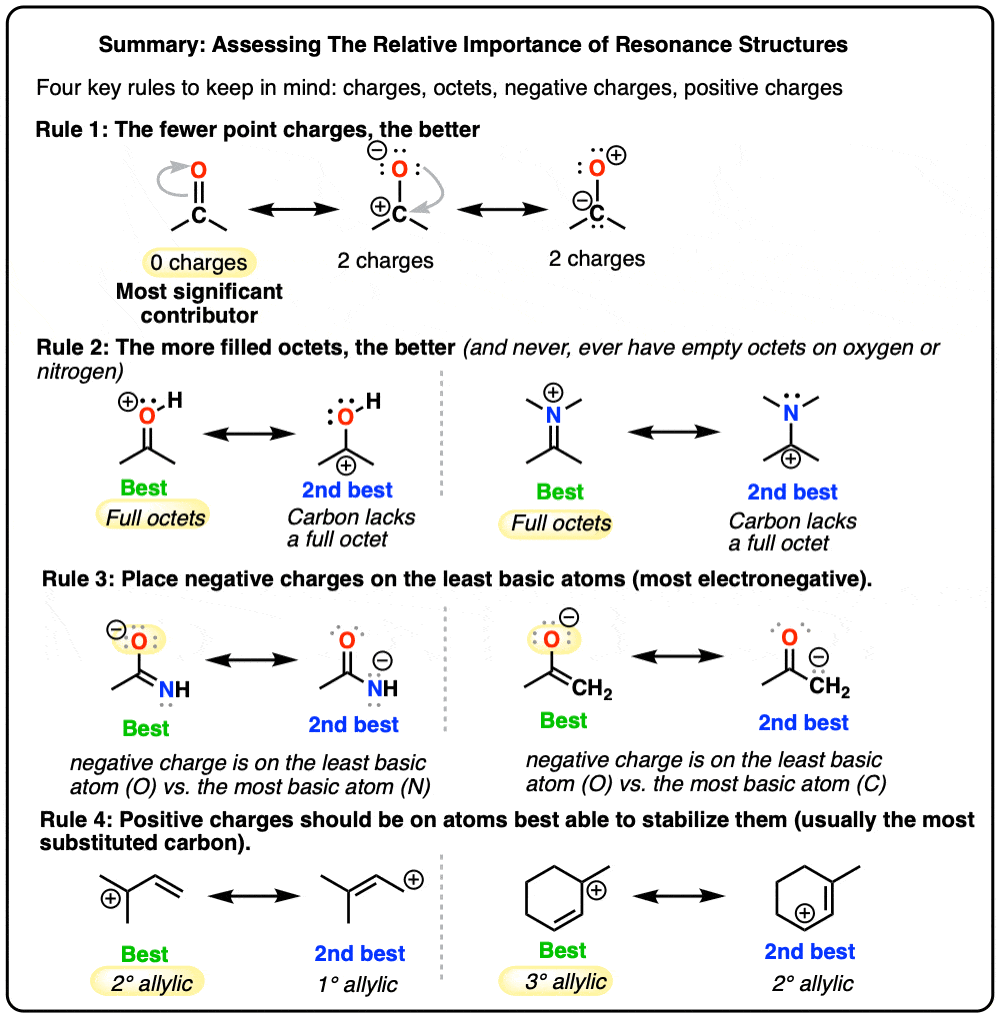
Table of Contents
- Recall The Three “Legal” Electron-Pushing Arrow “Moves” Used For Interconverting Resonance Structures
- Remember That Resonance Structures Are Not In Equilibrium With Each Other – They Represent Contributions To An Overall Resonance “Hybrid”
- Not All Resonance Forms Are Of Equal Significance. So How Do We Evaluate How “Important” Each One Is?
- Rule #1: Neutral Resonance Structures Are More “Important” Than Charged Resonance Structures
- Rule #2: Full Octets Are Preferable To Empty Octets (And Never, Ever Have Empty Octets On Oxygen or Nitrogen!)
- Rule #3: Place Negative Charges On The Atom Best Able To Stabilize It (i.e. The Least Basic Atom)
- Rule #4: Place Any Empty Octets On the Atoms Best Able To Stabilize Them (i.e. Carbon And Not Oxygen Or Nitrogen)
- An Application Of Resonance: “Pi Donation”
- A Second Application Of Resonance: “Pi Acceptors”
- Notes
- Quiz Yourself! (On Evaluating Resonance Structures)
1. Recall The Three “Legal” Electron-Pushing Arrow “Moves” Used For Interconverting Resonance Structures
After all these posts about resonance, I thought it would be good to have a post summarizing what’s been discussed so far.
One of the key skills in analyzing the reactivity of a molecule is to be able to figure out where the electrons are.
As I wrote here, if we’re dealing with single bonds, it’s a relatively straightforward matter of figuring out the differences in electronegativities.
However if multiple bonds (π bonds) are present, then we start to run into a little problem: there can be multiple ways to distribute electrons on the same molecule (i.e. different resonance forms). Therefore, in order to understand electron density on a molecule where pi bonds are present, we must first understand the importance of its various resonance forms.
How can we “find” resonance forms for a given molecule? It’s possible to do it through trial-and-error, but one surefire way is to do so is to apply the curved arrow formalism, which is a way of depicting the “movement” of electrons.
There are three “legal” ways to move electrons using curved arrows: from pi bond to lone pair, from lone pair to pi bond, and from pi bond to pi bond:
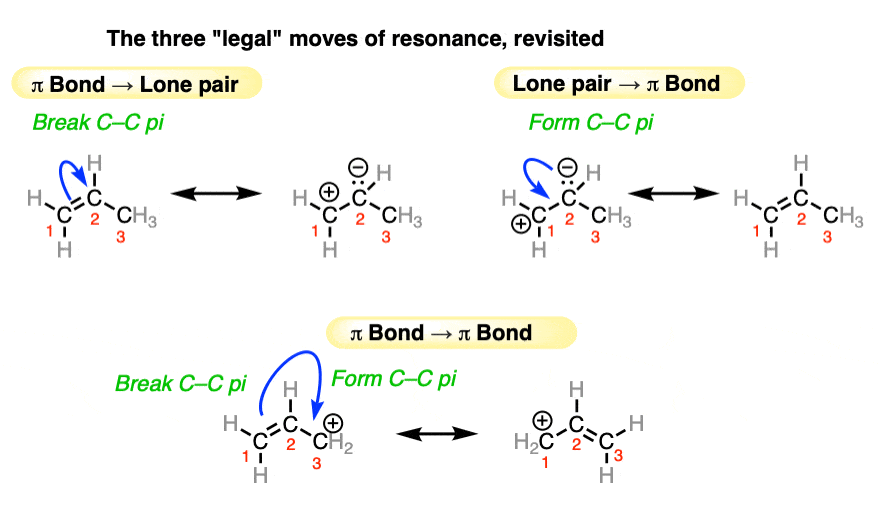
2. Remember That Resonance Structures Are Not In Equilibrium With Each Other – They Represent Contributions To An Overall Resonance “Hybrid”
Here’s an important point about resonance forms. It is tempting (and very wrong!) to think that these resonance forms are in “equilibrium” between each other. Avoid this common mistake!
Instead, the “true” state of the molecule will be a “hybrid” of these resonance forms.
For example in the acetate and allyl cation examples below, the “true” structure of the molecule is represented through a 50:50 combination of the two resonance forms.
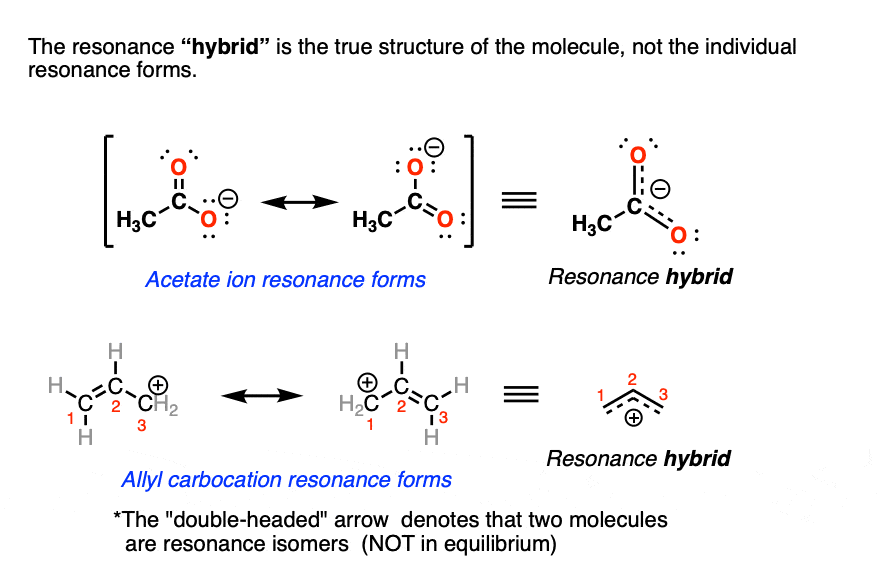
3. Not All Resonance Forms Are Of Equal Significance. So How Do We Evaluate How “Important” Each One Is?
In the case of the acetate ion and the allyl cation, both resonance forms are equal in energy, so the “hybrid” is a 1:1 mixture of the two. However, this is only rarely the case.
Take the ketone below (acetone, or “propanone”) for which we can draw 3 different resonance forms.
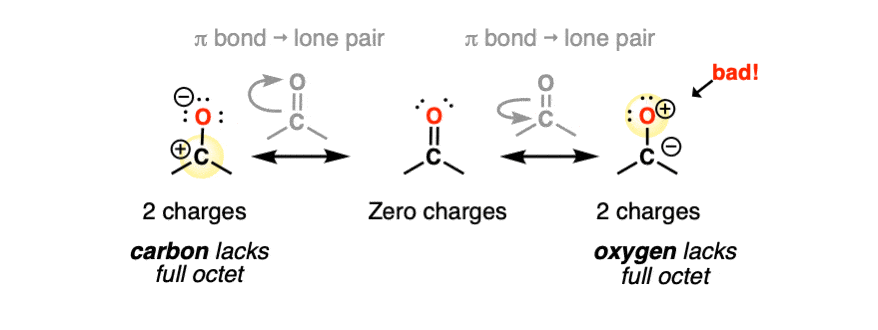
In cases like these, how do we evaluate the relative importance of each resonance form?
4. Rule #1: Neutral Resonance Structures Are More “Important” Than Charged Resonance Structures
Resonance forms become less significant as the number of charges are increased (see earlier post).
For example, in the ketone above, the resonance form with zero formal charges will be the most significant.
How do we know? We can measure the physical properties of the molecule (e.g. boiling points, solvent properties, conductivity) and see if it’s more consistent with a charged species or a neutral compound.
All the physical properties of propanone (acetone) are consistent with it being a (mostly) neutral molecule. For example acetone has a boiling point of 56°C, significantly lower than water, and a freezing point of –95°C. It doesn’t dissolve charged species (like NaCl) nearly as well as water does. And it isn’t a particularly good conductor of electricity.
That isn’t to say that the “second-best” resonance form doesn’t play some role.
Acetone is much higher-boiling than butane (–1°C) which has a similar molecular weight due to the dipole-dipole Van der Waals attractive forces, and as we’ll see later, the “second-best” resonance form can yield an important clue as to the reactivity of a molecule.
5. Rule #2: Full Octets Are Preferable To Empty Octets (And Never, Ever Have Empty Octets On Oxygen or Nitrogen!)
Resonance forms where all atoms have full octets will be more significant than resonance forms where atom(s) lack a full octet. Importantly, it’s a good general rule never to place less than a full octet on nitrogen or oxygen, as in the acetone example (above right). Since these atoms are highly electronegative, these resonance forms are extremely unstable and will be insignificant.
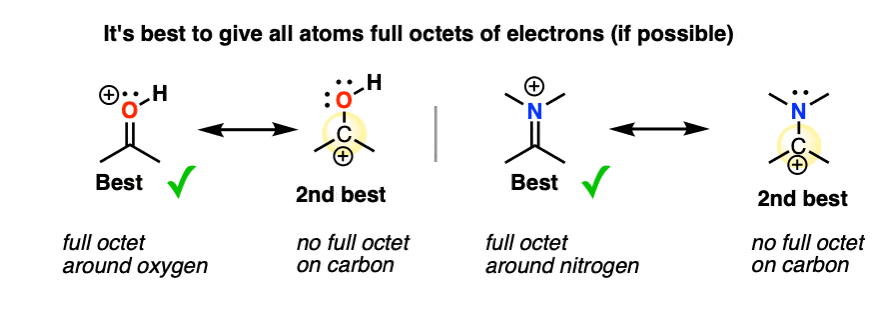
6. Rule #3: Place Negative Charges On The Atom Best Able To Stabilize It (i.e. The Least Basic Atom)
Given that neutral resonance structures are preferred overall, when a resonance structure absolutely must bear a negative charge somewhere, place it on the atom best able to stabilize that charge. Since, in essence, “basicity is the opposite of stability”, this is the same as saying, “put the negative charge on the least basic atom”.
The good news here is that if you understand the factors that affect acidity, you also understand the factors which stabilize negative charge.
There are four main trends to consider here:
- Electronegativity: across a row of the periodic table, negative charge becomes more stable as electronegativity is increased.
- Polarizability: down a column of the periodic table, negative charge becomes more stable as polarizability increases
- Electron withdrawing groups stabilize negative charge through inductive effects.
- Hybridization: negative charge becomes more stable as the s-character of the atom is increased. sp (most stable) > sp2 > sp3 (least stable
Note again that stability is the opposite of basicity.
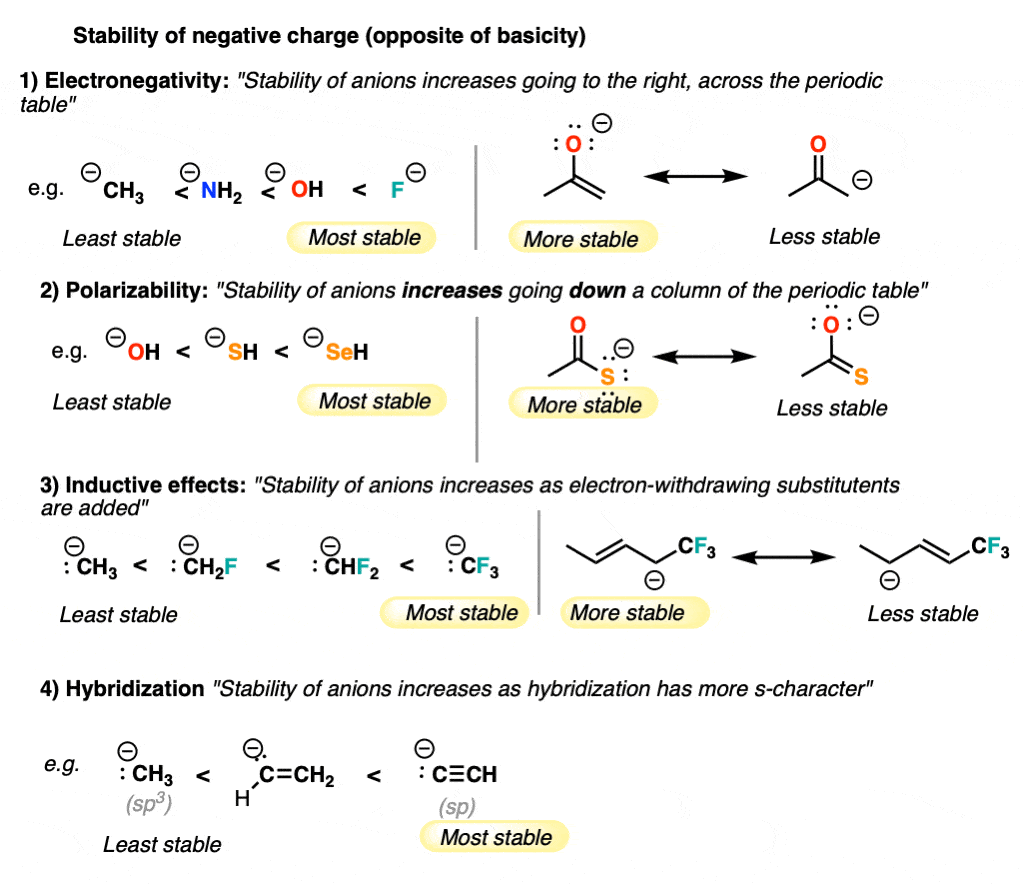
7. Rule #4: Place Any Empty Octets On the Atoms Best Able To Stabilize Them (i.e. Carbon And Not Oxygen Or Nitrogen)
As we said above, full octets are best. However, when dealing with a resonance structure where there absolutely must be an atom with less than a full octet, then follow these principles:
- Place the empty octet on carbon, never oxygen or nitrogen
- Place place the empty octet on the most substituted carbon (remember carbocation stability)
- Avoid placing positive charge adjacent to electron withdrawing groups if possible
- Place positive charge preferentially on alkyl carbocations as opposed to alkenyl or (especially) alkynyl carbons.
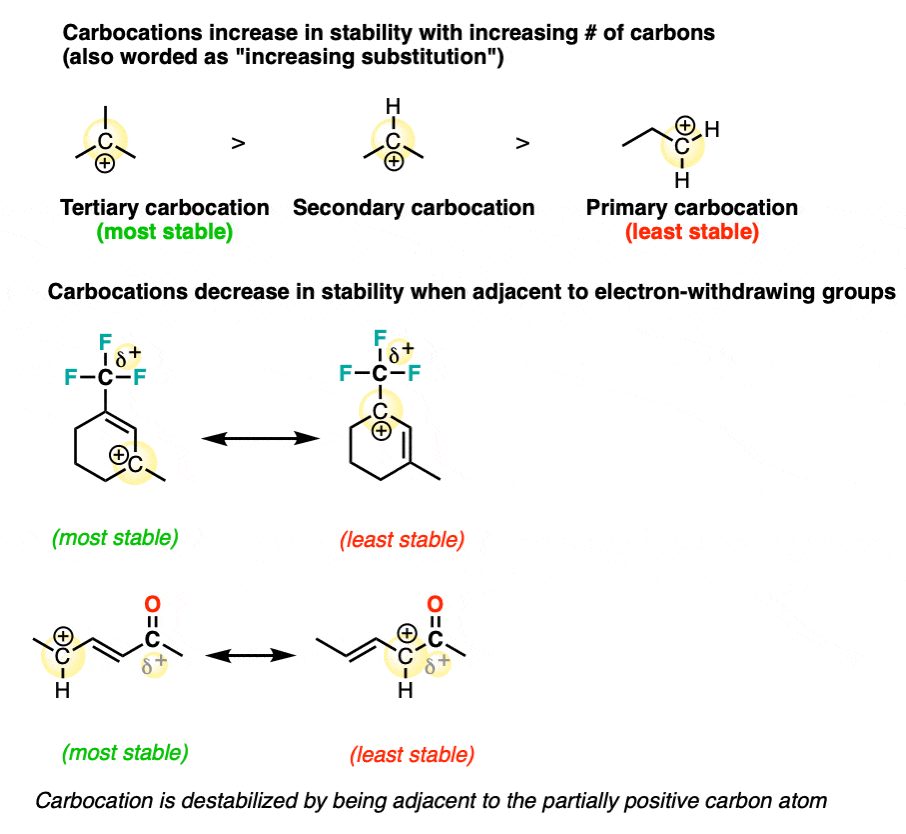
8. An Application Of Resonance: “Pi Donation”
When double bonds are connected to an atom with a lone pair of electrons, the molecule will have a significant resonance form where there is negative charge on the adjacent carbon due to a phenomenon called, “pi donation“. This becomes particularly important once you start learning about reactions of pi bonds.
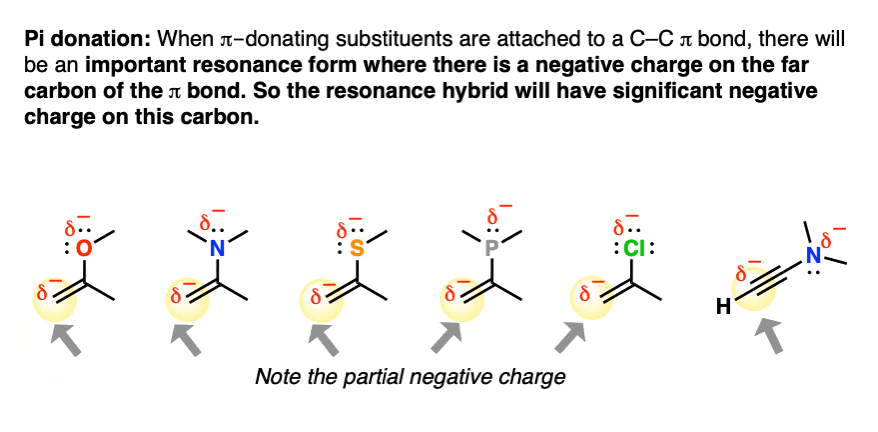
9. A Second Application Of Resonance: “Pi Acceptors”
When double bonds are connected to a polarized π bond, the molecule will have a significant resonance form where there is positive charge on the adjacent carbon. This phenomenon is known as “pi-accepting” behavior, and these groups are known as “pi acceptors“.
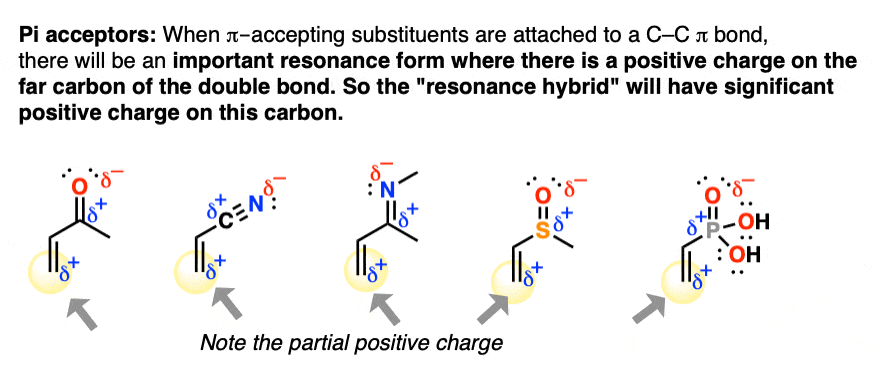
For now, that does it for a summary of the important themes in resonance. Next stop (after a post about some common mistakes) will be to apply these principles to chemical reactivity.
Next Post: Common Mistakes – How NOT to Draw Resonance Curved Arrows
Notes
Related Articles
- Drawing Resonance Structures: 3 Common Mistakes To Avoid
- Evaluating Resonance Structures With Negative Charges
- Evaluating Resonance Structures With Positive Charge
- How To Find The Best Resonance Structure By Applying Electronegativity
- How To Use Curved Arrows To Interchange Resonance Forms
- Exploring Resonance: Pi-Donation
- 3 Factors That Stabilize Carbocations
- 7 Factors that stabilize negative charge in organic chemistry
- Resonance Structures Practice (MOC Membership)
Quiz Yourself on Resonance Structures

Become a MOC member to see the clickable quiz with answers on the back.

Become a MOC member to see the clickable quiz with answers on the back.

Become a MOC member to see the clickable quiz with answers on the back.

Become a MOC member to see the clickable quiz with answers on the back.

Become a MOC member to see the clickable quiz with answers on the back.

Become a MOC member to see the clickable quiz with answers on the back.
00 General Chemistry Review
01 Bonding, Structure, and Resonance
- How Do We Know Methane (CH4) Is Tetrahedral?
- Hybrid Orbitals and Hybridization
- How To Determine Hybridization: A Shortcut
- Orbital Hybridization And Bond Strengths
- Sigma bonds come in six varieties: Pi bonds come in one
- Dipole Moments and Dipoles
- A Key Skill: How to Calculate Formal Charge
- The Four Intermolecular Forces and How They Affect Boiling Points
- 3 Trends That Affect Boiling Points
- How To Use Electronegativity To Determine Electron Density (and why NOT to trust formal charge)
- Introduction to Resonance
- How To Use Curved Arrows To Interchange Resonance Forms
- Evaluating Resonance Forms (1) - The Rule of Least Charges
- How To Find The Best Resonance Structure By Applying Electronegativity
- Evaluating Resonance Structures With Negative Charges
- Evaluating Resonance Structures With Positive Charge
- Exploring Resonance: Pi-Donation
- Exploring Resonance: Pi-acceptors
- In Summary: Evaluating Resonance Structures
- Drawing Resonance Structures: 3 Common Mistakes To Avoid
- How to apply electronegativity and resonance to understand reactivity
- Bond Hybridization Practice
- Structure and Bonding Practice Quizzes
- Resonance Structures Practice
02 Acid Base Reactions
- Introduction to Acid-Base Reactions
- Acid Base Reactions In Organic Chemistry
- The Stronger The Acid, The Weaker The Conjugate Base
- Walkthrough of Acid-Base Reactions (3) - Acidity Trends
- Five Key Factors That Influence Acidity
- Acid-Base Reactions: Introducing Ka and pKa
- How to Use a pKa Table
- The pKa Table Is Your Friend
- A Handy Rule of Thumb for Acid-Base Reactions
- Acid Base Reactions Are Fast
- pKa Values Span 60 Orders Of Magnitude
- How Protonation and Deprotonation Affect Reactivity
- Acid Base Practice Problems
03 Alkanes and Nomenclature
- Meet the (Most Important) Functional Groups
- Condensed Formulas: Deciphering What the Brackets Mean
- Hidden Hydrogens, Hidden Lone Pairs, Hidden Counterions
- Don't Be Futyl, Learn The Butyls
- Primary, Secondary, Tertiary, Quaternary In Organic Chemistry
- Branching, and Its Affect On Melting and Boiling Points
- The Many, Many Ways of Drawing Butane
- Wedge And Dash Convention For Tetrahedral Carbon
- Common Mistakes in Organic Chemistry: Pentavalent Carbon
- Table of Functional Group Priorities for Nomenclature
- Summary Sheet - Alkane Nomenclature
- Organic Chemistry IUPAC Nomenclature Demystified With A Simple Puzzle Piece Approach
- Boiling Point Quizzes
- Organic Chemistry Nomenclature Quizzes
04 Conformations and Cycloalkanes
- Staggered vs Eclipsed Conformations of Ethane
- Conformational Isomers of Propane
- Newman Projection of Butane (and Gauche Conformation)
- Introduction to Cycloalkanes
- Geometric Isomers In Small Rings: Cis And Trans Cycloalkanes
- Calculation of Ring Strain In Cycloalkanes
- Cycloalkanes - Ring Strain In Cyclopropane And Cyclobutane
- Cyclohexane Conformations
- Cyclohexane Chair Conformation: An Aerial Tour
- How To Draw The Cyclohexane Chair Conformation
- The Cyclohexane Chair Flip
- The Cyclohexane Chair Flip - Energy Diagram
- Substituted Cyclohexanes - Axial vs Equatorial
- Ranking The Bulkiness Of Substituents On Cyclohexanes: "A-Values"
- Cyclohexane Chair Conformation Stability: Which One Is Lower Energy?
- Fused Rings - Cis-Decalin and Trans-Decalin
- Naming Bicyclic Compounds - Fused, Bridged, and Spiro
- Bredt's Rule (And Summary of Cycloalkanes)
- Newman Projection Practice
- Cycloalkanes Practice Problems
05 A Primer On Organic Reactions
- The Most Important Question To Ask When Learning a New Reaction
- Curved Arrows (for reactions)
- Nucleophiles and Electrophiles
- The Three Classes of Nucleophiles
- Nucleophilicity vs. Basicity
- What Makes A Good Nucleophile?
- What Makes A Good Leaving Group?
- 3 Factors That Stabilize Carbocations
- Equilibrium and Energy Relationships
- 7 Factors that stabilize negative charge in organic chemistry
- 7 Factors That Stabilize Positive Charge in Organic Chemistry
- What's a Transition State?
- Hammond's Postulate
- Learning Organic Chemistry Reactions: A Checklist (PDF)
06 Free Radical Reactions
- Free Radical Reactions
- 3 Factors That Stabilize Free Radicals
- Bond Strengths And Radical Stability
- Free Radical Initiation: Why Is "Light" Or "Heat" Required?
- Initiation, Propagation, Termination
- Monochlorination Products Of Propane, Pentane, And Other Alkanes
- Selectivity In Free Radical Reactions
- Selectivity in Free Radical Reactions: Bromination vs. Chlorination
- Halogenation At Tiffany's
- Allylic Bromination
- Bonus Topic: Allylic Rearrangements
- In Summary: Free Radicals
- Synthesis (2) - Reactions of Alkanes
- Free Radicals Practice Quizzes
07 Stereochemistry and Chirality
- Types of Isomers: Constitutional Isomers, Stereoisomers, Enantiomers, and Diastereomers
- How To Draw The Enantiomer Of A Chiral Molecule
- How To Draw A Bond Rotation
- Introduction to Assigning (R) and (S): The Cahn-Ingold-Prelog Rules
- Assigning Cahn-Ingold-Prelog (CIP) Priorities (2) - The Method of Dots
- Enantiomers vs Diastereomers vs The Same? Two Methods For Solving Problems
- Assigning R/S To Newman Projections (And Converting Newman To Line Diagrams)
- How To Determine R and S Configurations On A Fischer Projection
- The Meso Trap
- Optical Rotation, Optical Activity, and Specific Rotation
- Optical Purity and Enantiomeric Excess
- What's a Racemic Mixture?
- Chiral Allenes And Chiral Axes
- Stereochemistry Practice Problems and Quizzes
08 Substitution Reactions
- Nucleophilic Substitution Reactions - Introduction
- Two Types of Nucleophilic Substitution Reactions
- The SN2 Mechanism
- Why the SN2 Reaction Is Powerful
- The SN1 Mechanism
- The Conjugate Acid Is A Better Leaving Group
- Comparing the SN1 and SN2 Reactions
- Polar Protic? Polar Aprotic? Nonpolar? All About Solvents
- Steric Hindrance is Like a Fat Goalie
- Common Blind Spot: Intramolecular Reactions
- Substitution Practice - SN1
- Substitution Practice - SN2
09 Elimination Reactions
- Elimination Reactions (1): Introduction And The Key Pattern
- Elimination Reactions (2): The Zaitsev Rule
- Elimination Reactions Are Favored By Heat
- Two Elimination Reaction Patterns
- The E1 Reaction
- The E2 Mechanism
- E1 vs E2: Comparing the E1 and E2 Reactions
- Antiperiplanar Relationships: The E2 Reaction and Cyclohexane Rings
- Bulky Bases in Elimination Reactions
- Comparing the E1 vs SN1 Reactions
- Elimination (E1) Reactions With Rearrangements
- E1cB - Elimination (Unimolecular) Conjugate Base
- Elimination (E1) Practice Problems And Solutions
- Elimination (E2) Practice Problems and Solutions
10 Rearrangements
11 SN1/SN2/E1/E2 Decision
- Identifying Where Substitution and Elimination Reactions Happen
- Deciding SN1/SN2/E1/E2 (1) - The Substrate
- Deciding SN1/SN2/E1/E2 (2) - The Nucleophile/Base
- SN1 vs E1 and SN2 vs E2 : The Temperature
- Deciding SN1/SN2/E1/E2 - The Solvent
- Wrapup: The Key Factors For Determining SN1/SN2/E1/E2
- Alkyl Halide Reaction Map And Summary
- SN1 SN2 E1 E2 Practice Problems
12 Alkene Reactions
- E and Z Notation For Alkenes (+ Cis/Trans)
- Alkene Stability
- Alkene Addition Reactions: "Regioselectivity" and "Stereoselectivity" (Syn/Anti)
- Stereoselective and Stereospecific Reactions
- Hydrohalogenation of Alkenes and Markovnikov's Rule
- Hydration of Alkenes With Aqueous Acid
- Rearrangements in Alkene Addition Reactions
- Halogenation of Alkenes and Halohydrin Formation
- Oxymercuration Demercuration of Alkenes
- Hydroboration Oxidation of Alkenes
- m-CPBA (meta-chloroperoxybenzoic acid)
- OsO4 (Osmium Tetroxide) for Dihydroxylation of Alkenes
- Palladium on Carbon (Pd/C) for Catalytic Hydrogenation of Alkenes
- Cyclopropanation of Alkenes
- A Fourth Alkene Addition Pattern - Free Radical Addition
- Alkene Reactions: Ozonolysis
- Oxidative Cleavage of Vicinal Diols With NaIO4 and Pb(OAc)4
- Summary: Three Key Families Of Alkene Reaction Mechanisms
- Synthesis (4) - Alkene Reaction Map, Including Alkyl Halide Reactions
- Alkene Reactions Practice Problems
13 Alkyne Reactions
- Acetylides from Alkynes, And Substitution Reactions of Acetylides
- Partial Reduction of Alkynes With Lindlar's Catalyst
- Partial Reduction of Alkynes With Na/NH3 To Obtain Trans Alkenes
- Alkyne Hydroboration With "R2BH"
- Hydration and Oxymercuration of Alkynes
- Hydrohalogenation of Alkynes
- Alkyne Halogenation: Bromination and Chlorination of Alkynes
- Oxidation of Alkynes With O3 and KMnO4
- Alkenes To Alkynes Via Halogenation And Elimination Reactions
- Alkynes Are A Blank Canvas
- Synthesis (5) - Reactions of Alkynes
- Alkyne Reactions Practice Problems With Answers
14 Alcohols, Epoxides and Ethers
- Alcohols - Nomenclature and Properties
- Alcohols Can Act As Acids Or Bases (And Why It Matters)
- Alcohols - Acidity and Basicity
- The Williamson Ether Synthesis
- Ethers From Alkenes, Tertiary Alkyl Halides and Alkoxymercuration
- Alcohols To Ethers via Acid Catalysis
- Cleavage Of Ethers With Acid
- Epoxides - The Outlier Of The Ether Family
- Opening of Epoxides With Acid
- Epoxide Ring Opening With Base
- Making Alkyl Halides From Alcohols
- Tosylates And Mesylates
- PBr3 and SOCl2
- Elimination Reactions of Alcohols
- Elimination of Alcohols To Alkenes With POCl3
- Alcohol Oxidation: "Strong" and "Weak" Oxidants
- Demystifying The Mechanisms of Alcohol Oxidations
- Protecting Groups For Alcohols
- Thiols And Thioethers
- Calculating the oxidation state of a carbon
- Oxidation and Reduction in Organic Chemistry
- Oxidation Ladders
- SOCl2 Mechanism For Alcohols To Alkyl Halides: SN2 versus SNi
- Alcohol Reactions Roadmap (PDF)
- Alcohol Reaction Practice Problems
- Epoxide Reaction Quizzes
- Oxidation and Reduction Practice Quizzes
15 Organometallics
- What's An Organometallic?
- Formation of Grignard and Organolithium Reagents
- Organometallics Are Strong Bases
- Reactions of Grignard Reagents
- Protecting Groups In Grignard Reactions
- Synthesis Problems Involving Grignard Reagents
- Grignard Reactions And Synthesis (2)
- Organocuprates (Gilman Reagents): How They're Made
- Gilman Reagents (Organocuprates): What They're Used For
- The Heck, Suzuki, and Olefin Metathesis Reactions (And Why They Don't Belong In Most Introductory Organic Chemistry Courses)
- Reaction Map: Reactions of Organometallics
- Grignard Practice Problems
16 Spectroscopy
- Degrees of Unsaturation (or IHD, Index of Hydrogen Deficiency)
- Conjugation And Color (+ How Bleach Works)
- Introduction To UV-Vis Spectroscopy
- UV-Vis Spectroscopy: Absorbance of Carbonyls
- UV-Vis Spectroscopy: Practice Questions
- Bond Vibrations, Infrared Spectroscopy, and the "Ball and Spring" Model
- Infrared (IR) Spectroscopy: A Quick Primer On Interpreting Spectra
- IR Spectroscopy: 4 Practice Problems
- 1H NMR: How Many Signals?
- Homotopic, Enantiotopic, Diastereotopic
- Diastereotopic Protons in 1H NMR Spectroscopy: Examples
- 13-C NMR - How Many Signals
- Liquid Gold: Pheromones In Doe Urine
- Natural Product Isolation (1) - Extraction
- Natural Product Isolation (2) - Purification Techniques, An Overview
- Structure Determination Case Study: Deer Tarsal Gland Pheromone
17 Dienes and MO Theory
- What To Expect In Organic Chemistry 2
- Are these molecules conjugated?
- Conjugation And Resonance In Organic Chemistry
- Bonding And Antibonding Pi Orbitals
- Molecular Orbitals of The Allyl Cation, Allyl Radical, and Allyl Anion
- Pi Molecular Orbitals of Butadiene
- Reactions of Dienes: 1,2 and 1,4 Addition
- Thermodynamic and Kinetic Products
- More On 1,2 and 1,4 Additions To Dienes
- s-cis and s-trans
- The Diels-Alder Reaction
- Cyclic Dienes and Dienophiles in the Diels-Alder Reaction
- Stereochemistry of the Diels-Alder Reaction
- Exo vs Endo Products In The Diels Alder: How To Tell Them Apart
- HOMO and LUMO In the Diels Alder Reaction
- Why Are Endo vs Exo Products Favored in the Diels-Alder Reaction?
- Diels-Alder Reaction: Kinetic and Thermodynamic Control
- The Retro Diels-Alder Reaction
- The Intramolecular Diels Alder Reaction
- Regiochemistry In The Diels-Alder Reaction
- The Cope and Claisen Rearrangements
- Electrocyclic Reactions
- Electrocyclic Ring Opening And Closure (2) - Six (or Eight) Pi Electrons
- Diels Alder Practice Problems
- Molecular Orbital Theory Practice
18 Aromaticity
- Introduction To Aromaticity
- Rules For Aromaticity
- Huckel's Rule: What Does 4n+2 Mean?
- Aromatic, Non-Aromatic, or Antiaromatic? Some Practice Problems
- Antiaromatic Compounds and Antiaromaticity
- The Pi Molecular Orbitals of Benzene
- The Pi Molecular Orbitals of Cyclobutadiene
- Frost Circles
- Aromaticity Practice Quizzes
19 Reactions of Aromatic Molecules
- Electrophilic Aromatic Substitution: Introduction
- Activating and Deactivating Groups In Electrophilic Aromatic Substitution
- Electrophilic Aromatic Substitution - The Mechanism
- Ortho-, Para- and Meta- Directors in Electrophilic Aromatic Substitution
- Understanding Ortho, Para, and Meta Directors
- Why are halogens ortho- para- directors?
- Disubstituted Benzenes: The Strongest Electron-Donor "Wins"
- Electrophilic Aromatic Substitutions (1) - Halogenation of Benzene
- Electrophilic Aromatic Substitutions (2) - Nitration and Sulfonation
- EAS Reactions (3) - Friedel-Crafts Acylation and Friedel-Crafts Alkylation
- Intramolecular Friedel-Crafts Reactions
- Nucleophilic Aromatic Substitution (NAS)
- Nucleophilic Aromatic Substitution (2) - The Benzyne Mechanism
- Reactions on the "Benzylic" Carbon: Bromination And Oxidation
- The Wolff-Kishner, Clemmensen, And Other Carbonyl Reductions
- More Reactions on the Aromatic Sidechain: Reduction of Nitro Groups and the Baeyer Villiger
- Aromatic Synthesis (1) - "Order Of Operations"
- Synthesis of Benzene Derivatives (2) - Polarity Reversal
- Aromatic Synthesis (3) - Sulfonyl Blocking Groups
- Birch Reduction
- Synthesis (7): Reaction Map of Benzene and Related Aromatic Compounds
- Aromatic Reactions and Synthesis Practice
- Electrophilic Aromatic Substitution Practice Problems
20 Aldehydes and Ketones
- What's The Alpha Carbon In Carbonyl Compounds?
- Nucleophilic Addition To Carbonyls
- Aldehydes and Ketones: 14 Reactions With The Same Mechanism
- Sodium Borohydride (NaBH4) Reduction of Aldehydes and Ketones
- Grignard Reagents For Addition To Aldehydes and Ketones
- Wittig Reaction
- Hydrates, Hemiacetals, and Acetals
- Imines - Properties, Formation, Reactions, and Mechanisms
- All About Enamines
- Breaking Down Carbonyl Reaction Mechanisms: Reactions of Anionic Nucleophiles (Part 2)
- Aldehydes Ketones Reaction Practice
21 Carboxylic Acid Derivatives
- Nucleophilic Acyl Substitution (With Negatively Charged Nucleophiles)
- Addition-Elimination Mechanisms With Neutral Nucleophiles (Including Acid Catalysis)
- Basic Hydrolysis of Esters - Saponification
- Transesterification
- Proton Transfer
- Fischer Esterification - Carboxylic Acid to Ester Under Acidic Conditions
- Lithium Aluminum Hydride (LiAlH4) For Reduction of Carboxylic Acid Derivatives
- LiAlH[Ot-Bu]3 For The Reduction of Acid Halides To Aldehydes
- Di-isobutyl Aluminum Hydride (DIBAL) For The Partial Reduction of Esters and Nitriles
- Amide Hydrolysis
- Thionyl Chloride (SOCl2) And Conversion of Carboxylic Acids to Acid Halides
- Diazomethane (CH2N2)
- Carbonyl Chemistry: Learn Six Mechanisms For the Price Of One
- Making Music With Mechanisms (PADPED)
- Carboxylic Acid Derivatives Practice Questions
22 Enols and Enolates
- Keto-Enol Tautomerism
- Enolates - Formation, Stability, and Simple Reactions
- Kinetic Versus Thermodynamic Enolates
- Aldol Addition and Condensation Reactions
- Reactions of Enols - Acid-Catalyzed Aldol, Halogenation, and Mannich Reactions
- Claisen Condensation and Dieckmann Condensation
- Decarboxylation
- The Malonic Ester and Acetoacetic Ester Synthesis
- The Michael Addition Reaction and Conjugate Addition
- The Robinson Annulation
- Haloform Reaction
- The Hell–Volhard–Zelinsky Reaction
- Enols and Enolates Practice Quizzes
23 Amines
- The Amide Functional Group: Properties, Synthesis, and Nomenclature
- Basicity of Amines And pKaH
- 5 Key Basicity Trends of Amines
- The Mesomeric Effect And Aromatic Amines
- Nucleophilicity of Amines
- Alkylation of Amines (Sucks!)
- Reductive Amination
- The Gabriel Synthesis
- Some Reactions of Azides
- The Hofmann Elimination
- The Hofmann and Curtius Rearrangements
- The Cope Elimination
- Protecting Groups for Amines - Carbamates
- The Strecker Synthesis of Amino Acids
- Introduction to Peptide Synthesis
- Reactions of Diazonium Salts: Sandmeyer and Related Reactions
- Amine Practice Questions
24 Carbohydrates
- D and L Notation For Sugars
- Pyranoses and Furanoses: Ring-Chain Tautomerism In Sugars
- What is Mutarotation?
- Reducing Sugars
- The Big Damn Post Of Carbohydrate-Related Chemistry Definitions
- The Haworth Projection
- Converting a Fischer Projection To A Haworth (And Vice Versa)
- Reactions of Sugars: Glycosylation and Protection
- The Ruff Degradation and Kiliani-Fischer Synthesis
- Isoelectric Points of Amino Acids (and How To Calculate Them)
- Carbohydrates Practice
- Amino Acid Quizzes
25 Fun and Miscellaneous
- A Gallery of Some Interesting Molecules From Nature
- Screw Organic Chemistry, I'm Just Going To Write About Cats
- On Cats, Part 1: Conformations and Configurations
- On Cats, Part 2: Cat Line Diagrams
- On Cats, Part 4: Enantiocats
- On Cats, Part 6: Stereocenters
- Organic Chemistry Is Shit
- The Organic Chemistry Behind "The Pill"
- Maybe they should call them, "Formal Wins" ?
- Why Do Organic Chemists Use Kilocalories?
- The Principle of Least Effort
- Organic Chemistry GIFS - Resonance Forms
- Reproducibility In Organic Chemistry
- What Holds The Nucleus Together?
- How Reactions Are Like Music
- Organic Chemistry and the New MCAT
26 Organic Chemistry Tips and Tricks
- Common Mistakes: Formal Charges Can Mislead
- Partial Charges Give Clues About Electron Flow
- Draw The Ugly Version First
- Organic Chemistry Study Tips: Learn the Trends
- The 8 Types of Arrows In Organic Chemistry, Explained
- Top 10 Skills To Master Before An Organic Chemistry 2 Final
- Common Mistakes with Carbonyls: Carboxylic Acids... Are Acids!
- Planning Organic Synthesis With "Reaction Maps"
- Alkene Addition Pattern #1: The "Carbocation Pathway"
- Alkene Addition Pattern #2: The "Three-Membered Ring" Pathway
- Alkene Addition Pattern #3: The "Concerted" Pathway
- Number Your Carbons!
- The 4 Major Classes of Reactions in Org 1
- How (and why) electrons flow
- Grossman's Rule
- Three Exam Tips
- A 3-Step Method For Thinking Through Synthesis Problems
- Putting It Together
- Putting Diels-Alder Products in Perspective
- The Ups and Downs of Cyclohexanes
- The Most Annoying Exceptions in Org 1 (Part 1)
- The Most Annoying Exceptions in Org 1 (Part 2)
- The Marriage May Be Bad, But the Divorce Still Costs Money
- 9 Nomenclature Conventions To Know
- Nucleophile attacks Electrophile
27 Case Studies of Successful O-Chem Students
- Success Stories: How Corina Got The The "Hard" Professor - And Got An A+ Anyway
- How Helena Aced Organic Chemistry
- From a "Drop" To B+ in Org 2 – How A Hard Working Student Turned It Around
- How Serge Aced Organic Chemistry
- Success Stories: How Zach Aced Organic Chemistry 1
- Success Stories: How Kari Went From C– to B+
- How Esther Bounced Back From a "C" To Get A's In Organic Chemistry 1 And 2
- How Tyrell Got The Highest Grade In Her Organic Chemistry Course
- This Is Why Students Use Flashcards
- Success Stories: How Stu Aced Organic Chemistry
- How John Pulled Up His Organic Chemistry Exam Grades
- Success Stories: How Nathan Aced Organic Chemistry (Without It Taking Over His Life)
- How Chris Aced Org 1 and Org 2
- Interview: How Jay Got an A+ In Organic Chemistry
- How to Do Well in Organic Chemistry: One Student's Advice
- "America's Top TA" Shares His Secrets For Teaching O-Chem
- "Organic Chemistry Is Like..." - A Few Metaphors
- How To Do Well In Organic Chemistry: Advice From A Tutor
- Guest post: "I went from being afraid of tests to actually looking forward to them".
I have understand this but I have a very small doubt that
What is Resonance why do we make resonating structures ?
We make resonance structures because it is otherwise very difficult to simply show the electron density in structures with partial bonds.
What about charge separation how does that factor stack up against other factors you have mentioned???
I see absolutely no case for charge separation being a factor. Opposite charges attract anyway.
General chemistry teaches the evils of charge separation, but far, far overstates it. Charge separation is awful in the gas-phase, but in polar/complexing solvent, it is not nearly as bad as is suggested. The bigger, overriding issue is not the charge separation but the lack of the octet that normally accompanies it. I’d take charge separation with octets over no-charge separation without octets (take that “expanded octet” nonsense!).
But even with lack of octets, we know that charge separation is not bad when you have polar bonds. The carbonyl is a very polar bond. Hence, we can say that the polarized resonance structure is important.
Thanks for weighing in Paul!
Please tell me about the resonance effect of NO group on benzene ring.
NO is a sigma acceptor but a pi donor. It is an ortho-para director, similar to halogens. https://www.masterorganicchemistry.com/2018/03/05/why-are-halogens-ortho-para-directors/
does low stable molecule contribute to resonance
I have problems when i try to find out the hybridisation in the structures which show the phenomenon of resonance.Can’t we find it out using steric no.? Also I had problems regarding how will the electron density be represented in the p orbital or pi orbital.I just get confused when I try to fin the relation between vbt, mot and resonance
Got it!a nice treatment on my doubts on http://web1.uct.usm.maine.edu/~newton/Chy251_253/Lectures/Aromaticity/AromaticityFS.html
Also this pdf helps:http://www.chem.ucla.edu/harding/tutorials/aromaticity.pdf
BTW It’s an exceptional site you have got there and It’s helped me even more than my tuition teacher!
Yes – UCLA is a great site.
uhhhhh……
I actually mentioned your site as great!!!
Thanks James. In your answer, you touch upon something we often take for granted, but which I will call “implicit semantics”. If the participants in the “shared space” all agree that they know an anionic centre has an “invisible” lone pair, then of course it is OK to start the arrow at the charge and dispense with drawing the lone pair. But I remind of the fascinating story of how benzene has been represented over the years. Faraday who discovered it, attributed no structure. Loschmidt controversially represented it as a circle, and Kekule gets the credit for the final form. But after that chemists got lazy. They dispensed with Kekule’s two forms, reducing them not only to one (the other being now implicit) but they also eliminated the three double bonds, making these also implicit. For perhaps 70 years, it became normal to draw a benzene ring as a pure hexagon, and to leave the unsaturation as implicit. Text books up to around 1950 appear to be describing cyclohexane, whereas in fact we might conclude that they are actually referring to benzene itself..
Benzene is also associated with another form of implicit meaning. Robinson around 1925 coined the term aromatic sextet, and mesmerised by this, anointed naphthalene with two rings (after all, the two rings are related by a plane of symmetry). The use of two such inner circles for naphthalene implies two sextets, or 12 π electrons. Of course we know that two such sextet rings actually implies 10 electrons! See what happens when you take short cuts!
Thanks for the historical perspective. I was unaware about the cyclohexane example. And the doubly circled rings for naphthalene is definitely something to avoid.
[I made a longer comment previously but decided to delete it. There’s too many misunderstandings possible when communicating through blog comments].
The very first diagram above shows some curved arrow formalism (with a reference to Wikipedia). The second example shows a lone pair to π-bond resonance. It might seem trivial, but it does matter where one shows an arrow “starting” from; in this case a negative charge on a carbon. Might I suggest that a slightly more consistent approach is to start arrows not so much at charges, but at the associated lone pair (also shown in your diagram). One can locate the centroids of electron (pairs), and therefore in principle one can define coordinates for the start of an arrow (and also by the same principle, coordinates for the destination of the arrow). It is not however possible to define coordinates for a “charge” (other than placing it at the centre of the atom itself, which is hardly a very electronic thing to do!).
I have touched upon this theme here where you might want to contemplate the arrows for the reverse of the three reactions shown. Also here.
Thanks for the input Henry. You’ve pointed out a common dilemma. It is indeed more consistent to show arrows starting at lone pairs instead of charges. There are costs and benefits to each approach. The benefit of drawing all the lone pairs in is that there is no ambiguity about the location of the electrons and it is more proper to do so. There is, however, a cost both in the extra clutter of the drawings and also in the extra time involved in drawing in these lone pairs. For that reason it is *extraordinarily* common for students and instructors to omit drawing lone pairs when a formal negative charge *and* a lone pair is present on the same atom, and simply draw the curved arrow as coming from the charge (in the absence of a formal negative charge, a corresponding lone pair *must* be drawn in however). I choose to do this as well. So long as this caveat is understood (i.e. that the negative charge “stands in” for a lone pair on the atom) in my experience there has been little confusion on this point. However it is not without regret that some information content is lost.
Fixed the diagram. You’re right, it was a little sloppy coming from the charge instead of the lone pair. Thanks for the correction.
Maybe I missed it in earlier blogs, but what exactly is resonance? Do you think of it as superposition, where several different structures exist at the same instant? If so, then you cannot think of any of your structures as single molecules. But if you think in terms of single molecules, then only one of these structures can exist at any instant. Then the molecule resonates between these structures, but this is not superposition?
To me, resonance represents all the possible structures that can simultaneously exist for a single particle, but at any instant the molecule can have only one structure. That is, superposition is different from resonance. But then, again, I am a physical chemist.
Thanks Bryan – resonance structures are a kind of kludge, which have been developed due to the limitations of our system of chemical formulae (and formal charge) in accurately depicting electron densities. The resonance forms are not themselves isolable or “real” but can be thought of as components that contribute to the overall electronic structure of the molecule, which is a weighted hybrid of resonance structures.
I like Bruice”s analogy, here – http://i.imgur.com/tow7V.jpg
You should also include a collection of Common Resonance Errors like trying to draw a pi-bond to pi-bond arrow for an allylic anion, etc.
You have an uncanny ability to read my mind, sir. That is next